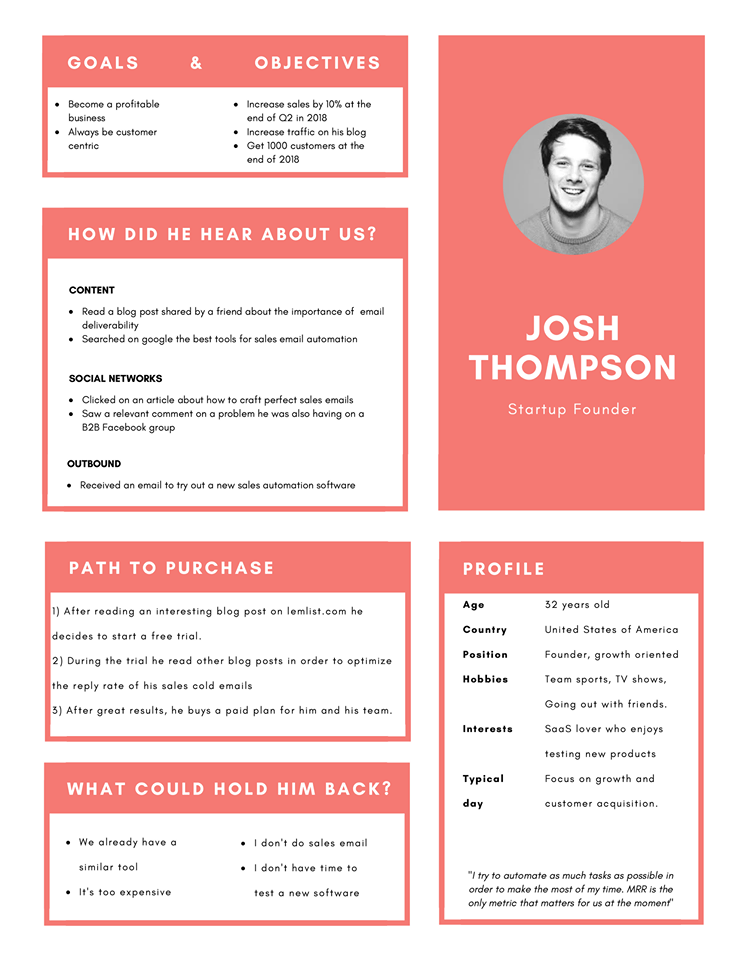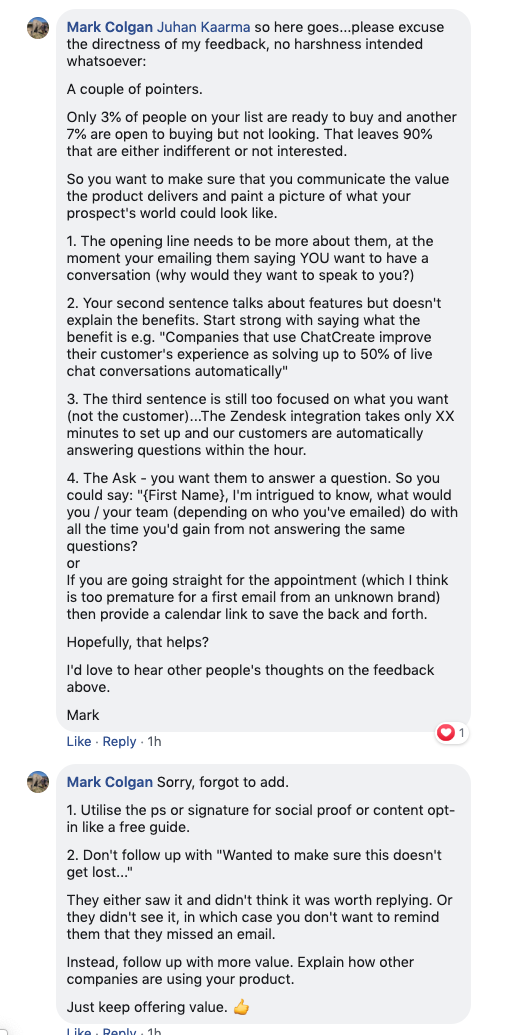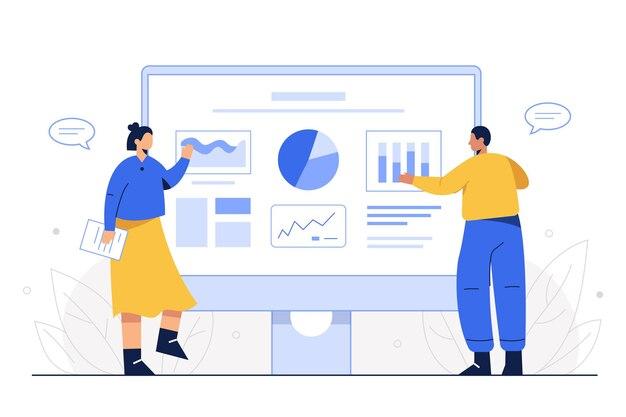Today it’s harder than ever before to close great deals.
You are giving your best to close your deals and prove yourself to the other colleagues. But the results aren’t even close.
Without a doubt, the old B2B sales process you used to implement 5 years ago, doesn’t work anymore. The market has changed. People have changed.
You will need to implement some new and more engaging B2B sales process if you desire to achieve great results for your company.
Just think about it: the more deals you close, the more respect you will enjoy by your teammates.
Doesn’t that feel amazing?
In this article, we will exactly what to do if you want to make a killer B2B sales process.
Let’s get started!
Although this may seem so obvious, even if we’re living in 2019, a lot of sales reps are poorly conducting their research before they’re outreaching to the prospects.
We can find countless data on the Internet. Almost any information we need is at the top of our hand.
Seriously.
Let’s start with why. Why do we need to conduct in-depth research of our prospects?
The answer is simple.
More information we have about a prospect, we will be able to better personalize the entire B2B sales process and user journey.
We can send more personalized and engaged cold emails, we will know what are his biggest pain points, and what are his greatest desires.
Let’s see how great prospect research should look like:
Your most ideal buyer persona is the CEO of a SaaS company with more than 1000 employees and more than 100M in ARR.
Here is how a good prospect data looks like (usually, you will fill your information inside CRM or a spreadsheet, but for readability purposes, we will surface it in lines):
Another example is from Lemlist. As you can see below:

Do you see how the perfect prospect research looks like? Keep in mind that here we outlined just basic information you can collect about someone. There are many more data that can be useful for your B2B sales process – but again, the data you will use mostly depends on the product you’re offering.
Without a doubt, the more information you have about the prospects, there are bigger chances that they will respond to your cold email, and eventually, you will close the deal.
Check our : Callback software features .
The biggest problem here is that conducting such great research requires time, and it’s not scalable. But at the end of the day, you can’t create personalized sales campaigns and B2B sales process without personalized data.
Sometimes, it’s not just enough to find out someone’s email address, write copy, and send massive cold emails.
You should add a little bit more high-touch to your B2B sales process.
That’s exactly what we’re covering next!
There is nothing more appreciated than showing your ideal prospects that you care about them.
If you don’t personalize your first contact with your prospects, it’s a clear sign that you don’t respect them. And no, I’m not talking here about using their name or mentioning their company.
You really need to give your best for this.
There is a reason why the very first emails you send to your prospects are called cold emails. They already don’t know who you are. They know nothing about you and your company. But the only thing they know (or assume), is that you’re trying to sell something. And that really knows to annoy people.
Nevertheless, you have very small chances for success when you’re sending your first email. At least, you can try to warm your email a little bit by adding some personalized notes or facts.
Here are a couple of ideas for crafting more personalized cold emails:
Let’s see how to personalize your emails on an actionable way by following the example below.
If you are sending your cold email to the Brian Halligan, the very first email could look like this:
Hi Brian,
Hope Red Sox will win the game against OAK tomorrow!
Let me go straight to the point – I saw your TEDx talk where you’re explaining about the real struggles of managing employees in big companies. I know that it’s a real problem to worry about thousands of people and keep an eye on them.
For that reason, I would like to present to you the EmployeeX tool. It helps you to worry less about your teammates and have clear insights on everything that’s going on inside the company.
Let me know what time suits you best next week to schedule a 15-minute call.
Wish better team control and a great day,
Ugljesa
P.S.
Perhaps we can play some quick game of tennis when I visit Cambridge in May?
Note: don’t include this much of bolded text inside your email body – We bolded text here just to show you the in-email personalization.
Do you catch the point? There are 8 personalization events inside one single, short and straight-forward email. Who would say that’s not possible?
One day, in some Facebook B2B sales experts’ group, someone shared its cold email and follow up templates and asked for feedback:

Mark Colgan, Director at YelowO, shared his feedback and advice on this example:

Here are the key takeaways and lessons from this in-depth response:
“Only 3% of people are ready to buy your product or service. Another 7% are interested in buying it, but not looking, while 90% of people are not interested at all.
1. The opening line of your email needs to be about your prospects.
2. Your second sentence should start bold and explain the benefits of your product
3. The third sentence should be focused on your customers and their desires
4. You want them to answer your question – so you need to ask them something.
5. P.S. section should utilise social proof or content opt-in like a free guide.
6. Follow up with strong value-based emails”
A lot of us find ourselves distracted in the ocean of bad and non-interested prospects and leads.
The more prospects we have on our table, the more work we have to do. Because of this, our work quality is lower and we are closing fewer deals.
The one of the most important things about a modern B2B sales process is to only focus on quality leads.
There is no need to waste our time and energy on something that won’t work.
Instead of working with hundreds of non-interested prospects, let’s work with a few most ideal ones.
That’s the reason why we need to conduct a great ideal buyer persona research at the beginning.
Of course, you will never know which prospect can be considered as a “qualified” lead.
Unfortunately, you must qualify him by yourself.
The best way to empower your B2B sales process with qualified leads is to ask the right questions.
So, instead of being blind and focusing on all prospects at the same time, let’s see what are the best questions for the lead qualification:
Literally, there are dozens of questions you could ask your potential prospects.
And having the answer to each of these questions will help you to know is this lead worth your time and attention.
Another great way to qualify your leads is to monitor their inbound journey.
When you realize that someone visited your pricing page a couple of times and that he’s reading your blog over and over again, probably, he can be considered as a “qualified” lead.
Although this is a great method for a lead qualification – it can be really hard and exhausting to identify leads personally.
For example, you can set up different goals inside your Google Analytics account, and track down who is doing what on your website.
Or, you can use some callback software like Limecall to both qualify leads and close the deals.
Callback software is embedded in your websites, and it qualifies your website visitors.
Whenever it finds out that someone is interested in your product, it considers him “qualified” and offer him a call in 30 seconds.
After you make your initial contact with your prospects and mark them as “qualified”, the next step in the B2B sales process is to build credibility.
Your prospects will not buy from you if they don’t respect you.
Simple as that!
So, let’s see what are some of the best ways to build credibility and gain respect.
There is nothing more beautiful than showing your prospects that you care about their accomplishments and goals.
Instead of selling them your product, try to sell them more value.
Become personally interested in their business and offer them help even if they don’t need it.
For example, if you are a software or SaaS company, set up an account for your trial users or simply lead them through your product one on one.
If you own a marketing agency, organize for your clients meetings and courses with sales experts – at your cost.
If you are working in the car insurance company, share with your prospects on how to effectively maintain their cars, or give them the numbers of the best auto mechanic.
It doesn’t matter in which industry you are, as long as your “expertise” can help them to reach their goals.
Another great way to build credibility is to focus on small things.
Try to remember (or write down), your prospect’s birthdays, the food they like or even the music they love the most.
Send them their favourite song as a motivation for the upcoming day, or simply, thank them personally via postcard.
Everything counts.
In the B2B sales process, your only focus should be on leads and prospects.
Even today, we can see a lot of sales reps who are only talking about the benefits of their products.
Let’s be honest – no one cares about that.
No one cares about the drill specifications – we only care about the hole in the wall.
When I want to buy a new set of notebooks for my employees, I don’t care about the specifications – I only care would that notebooks make my employees more productive.
So, the key takeaway is:
Don’t talk too much about your product or service. Instead, talk about benefits and educate your leads on the topic.
For example, you own a product that helps people monitor their competition.
Instead of saying:
Our product helps you to monitor your competitors’ social media
say:
Our product helps you to be the first who will find out your competitors’ new social media strategies and take action that will help you to use their campaigns in your advantage by creating amazing competitive advantages.
See the difference here?
After you got your prospects with talking about the benefits instead of the specifications, it’s time to educate your users.
You can host webinars, write actionable articles and how to’s. Whatever you can imagine.
The purpose of educating your leads is not to teach them how to use your product, but how to get the most out of it with the important industry knowledge.
Look at HubSpot for example.
Their blog is not about “best tricks and tactics to use Hubspot”, but instead, it’s about how to be better at sales and marketing.
A great way to educate your leads is to create a content library or a knowledge base, where you will answer all questions your leads can have during their buyer journey and sales funnel.
As far as you can see, the perfect and modern B2B sales process is based on:
Fulfilling each of these 4 stages is crucial if you want to close a deal in 2019 and coming years.
What are your biggest struggles in when it comes to building enduring B2B sales process? Let us know in the comments! We will be more than happy to help you!
Here is some additional resource you might be interested in:
, May 4, 2019, Ugljesa Djuric

Top rated callback automation platform that connects your website visitors to your team within 20 seconds through phone callback and whatsapp driving upto 40% more conversions.
Learn more